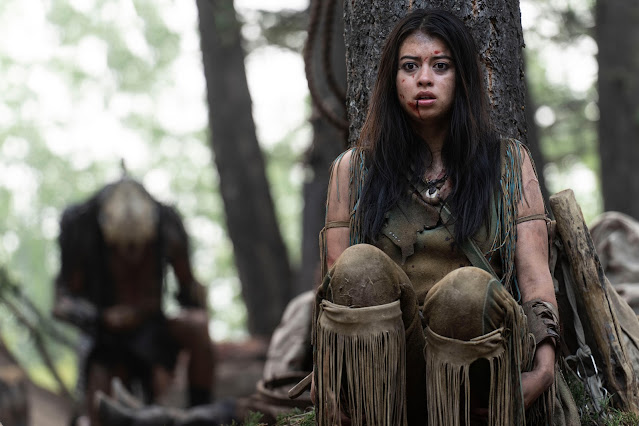So what did Prey do? It does what any effective prequel does and brings everything back to the basics. In fact, it’s so dedicated to being a prequel that it’s set over 250 years before the original Predator, and it works as a decoupled prologue to the series without interfering with any canon or lore — this is in comparison with Shane Black’s film, which tried far to hard to establish the opposite.
 |
| Image courtesy of 20th Century Studios |
It’s not explained at all in this film — again, there’s little to no mention of any lore — but hunting “worthy opponents” is at the center of the Predators’ culture, and though the alien warrior we meet in Prey doesn’t have quite the same technological development we’ve seen in previous Predator films, it’s still worlds away more advanced than what is at humans’ disposal. Theoretically, this Predator should win any fight easily on Earth in 1719.
But that would be underestimating its own prey, the downfall of any proud hunter. In fact, that’s a stellar through-line in Prey, which centers around a nation of Native Americans who have to hunt to survive. Sure, the Predator is physically stronger, but does it have the cunning or the drive to measure up to a steadfast Comanche warrior?
 |
| Image courtesy of 20th Century Studios |
And then there’s the elephant in the room: Prey is a Hulu original, with only a one-night theatrical screening at San Diego Comic-Con this year. I’m lucky enough to work at a movie theater, and I’m glad I came into work early last week to watch this on the biggest screen I could find; the rolling landscapes, epic scale and in-your-face action is perfect to be seen on the silver screen. But at the same time, there’s something about it that feels small — almost like it had the budget of a streaming original, but the imagination of a big-screen hit. I know I’m not the first to say that this deserved a theatrical release, but I also think that the scope could have been even broader had it been given the budget and time necessary for a big-screen release.
Also, this is the first movie to receive a full dub in the Comanche language upon release, courtesy of the film’s stars. Not only is this historic, it also deepens the immersion, creating a more convincing version of this already well-rounded depiction of the not-too-distant past. Even in the English version, the occasional spoken Comanche and French are left unsubtitled, taking a cue from 2021’s West Side Story, which did the same thing with spoken Spanish. It’s a natural thing, and we don’t need to know what everything means — context is key. To be clear, though, the Comanche dub is subtitled, while the English version is not.
 |
| Image courtesy of 20th Century Studios |
As a fan of the series since I first saw Alien vs. Predator (I know, I know…), I believe there’s hope for this franchise yet!
Prey is streaming on Hulu.

No comments:
Post a Comment